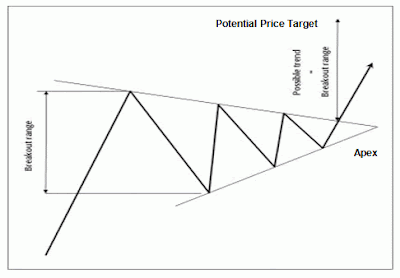Go back to
Part 1: Ascending Triangle FormationImportant Characteristics of Ascending Triangle PatternExisting Trend:There should be an established existing trend (normally uptrend) in order for the pattern to qualify as a continuation pattern.
Shape of Ascending Triangle:* There should be at least two equal peaks (highs) forming a horizontal upper line, and two successively higher troughs (lows) forming an ascending lower line that converges on the upper line as it slopes upward.
* There should be some distance between the two peaks as well as the two troughs.
In other words, prices should increase and hit the upper line then decline for at least twice (forming at least two peaks). Prices should drop and hit the upward sloping lower line then bounce up for at least twice (forming at least two troughs).
* The upper line does not need to be completely horizontal, but it should be close to horizontal.
* The peaks (highs) do not have to be exactly the same in value, but they should be reasonably close.
* Prices should bounce back and forth in a quite regular pattern as the Triangle develops.
Volume:
Volume should be diminishing; heavy at the beginning and contracts as the pattern develops.
However, when breakout occurs, there should be a significant increase in volume.
This is because during the development of the pattern, investors are still undecided. Some are holding on to their stocks, awaiting the market's next move, whereas the others are buying and selling sooner, which translates into a narrowing range of the peaks and troughs. (They profit take or short sell at the upper line that acts as resistance).
When breakout finally occurs, volume should increase significantly, because investors finally have enough conviction about the market direction and they are eager to release their pent-up supply or demand.
Duration:
On a daily chart, this pattern usually may take about 1 to 3 months to form.
Generally, the longer it takes to form the triangle (or the longer the timeframe of the triangle formation), the stronger the breakout would be.
Potential Price Target:
1) Compute the height of the triangle at its widest part (on the left of the chart).
The height is determined by projecting & measuring a vertical line from the horizontal upper line to the lowest low point on the lower line.
2) Add the result to the breakout point (i.e. horizontal upper line) to get the potential price target.
Return to Breakout Level:
After the breakout through the upper line has occurred, it is common that prices could retrace to the upper line for an immediate test of this new support before resuming their upward moves.
This is because the upper line that previously acted as resistance has now turned into support.
(Remember the basic principle of technical analysis that resistance turns into support, or vice versa).
However, it should not reenter the triangle and/or even close below the lower line.
Breakout Direction:
Ascending Triangle is generally considered as bullish pattern (i.e. the breakout should be to the upside).
Nevertheless, it may sometimes break to the downside too (i.e. break down through the lower line).
When Breakout Should Occur:
The breakout from a Triangle pattern should occur well before the pattern reaches the apex of the triangle (i.e. should be somewhere between two-thirds and three-quarters of the horizontal width of the triangle).
If breakout does not occur beyond the three-quarter point, it might mean that prices would continue to drift out to the apex and beyond. In other words, the pattern may no longer valid.
False Breakout:Premature / false breakouts or "shakeouts" often happen to this pattern as well.
The following are a few points to take note in order to try to avoid false breakout:
* A minimum penetration criteria for a breakout should be price closes outside the upper line (when breakout to the upside) or lower line (when breakout to the downside), not just an intraday penetration.
Some investors / traders may apply certain price criteria (e.g. 3% - 5% break from the upper / lower line, depending on the stock�s volatility) or time criteria (e.g. the breakout is sustained for 3 days) to confirm the validity of the breakout.
* Normally, a breakout from a triangle pattern occurs due to an �event� or new development that is able to provide enough conviction to the investors / traders to move strongly to a certain direction.
Therefore, some possible confirmation for a valid breakout could be price gaps or accelerated price movements, which are accompanied by a significant increase in volume.
* When a breakout is not accomplished by high volume, investors / traders should be cautious. Because a good breakout from a triangle formation should happen with a significant increase in volume. However, not all breakouts with high volume are reliable either. A false breakout may also occur with high volume.
Therefore, the price action on the following days should be watched carefully. It is sometimes wise to wait a few days to determine whether the breakout is a valid one. Hence, some investors / traders prefer to take positions when the prices return to the breakout level to test the new support / resistance before resuming their moves to the breakout direction (although this return does not always happen), because this may offer an opportunity to participate in the breakout with a better reward to risk ratio.
* When the breakout occurs very close to the apex, investors / traders should be extra cautious. Because the chances of a false breakout are very high as the volume is thin at this point. Hence, it would only take very little activity to cause an erratic and false movement that takes the price outside of the upper or lower lines.
To read about other chart patters, go to:
Learning Charts PatternsRelated Posts:*
Learning Candlestick Charts*
Options Trading Basic � Part 2*
Understanding Implied Volatility (IV)*
Option Greeks*
FREE Trading Videos from Famous Trading Gurus 10:45 PM
10:45 PM
 killnine
killnine






